Preface
Organization of the Book
Anticipated Audience
Acknowledgments
Contents
Acronyms
Part I Getting Started
1 Background and Overview
1.1 Wireless Indoor Localization
1.2 State-of-the-Art Approaches
1.2.1 Infrastructure
1.2.2 General Architecture
1.2.3 Historical Stages
1.3 WiFi Fingerprint-Based Approach
1.3.1 General Frameworks
1.3.2 Challenges for Ubiquitous Applications
1.4 Book Organization
References
2 Mobile Crowdsourcing and Inertial Sensing
2.1 Harnessing Crowdsourcing in Mobile Computing
2.2 Embracing Mobility via Inertial Sensing
2.2.1 Sensors Types
2.2.2 Mobility Information
2.2.2.1 Displacement Information
2.2.2.2 Direction Information
2.2.2.3 Integrated Information
References
Part II Boosting Deployment: Making It Available
3 Radio Map Construction Without Site Survey
3.1 Introduction
3.2 Related Work
3.3 Overview
3.3.1 Data Collection
3.3.2 System Architecture
3.4 Stress-Free Floor Plan
3.5 Fingerprint Space
3.5.1 Fingerprint Collection
3.5.2 Pre-processing
3.5.3 Fingerprint Space Construction
3.6 Mapping
3.6.1 Feature Extraction
3.6.1.1 Corridor Recognition
3.6.1.2 Room Recognition
3.6.1.3 Reference Point Mapping
3.6.2 Space Transformation
3.6.2.1 Floor-Level Transformation
3.6.2.2 Room-Level Transformation
3.7 Experiments
3.7.1 Experiment Design
3.7.2 Performance Evaluation
3.7.2.1 Fingerprint Space Generation
3.7.2.2 Mapping Performance
3.7.2.3 Localization Error
3.8 Conclusion
References
4 Building Tomography: Automatic Floor Plan Generation
4.1 Introduction
4.2 Related Works
4.3 System Overview
4.4 Trace Collection
4.4.1 User Data Collection
4.4.2 Dead-Reckoning
4.5 Trace Realization
4.5.1 Entrance Discovery
4.5.2 Reference Point Extraction
4.5.3 Reference Point Matching
4.5.4 Drift Fixing
4.5.5 Multi-floor Case
4.6 Map Generation
4.6.1 Space Regionalization
4.6.2 Functionality Recognition
4.7 Experiments
4.7.1 Experiment Setup
4.7.2 Reference Point Matching Performance
4.7.3 Regionalization Performance
4.7.4 Functionality Recognition
4.8 Conclusion
References
Part III Facilitating Maintenance: Making It Sustainable
5 Adaptive Radio Map Updating
5.1 Introduction
5.2 Related Works
5.3 Preliminaries and Measurements
5.3.1 Measurements of RSS Dynamics
5.3.2 Radio Map Updating with Reference Points
5.4 Overview
5.5 Method Design
5.5.1 Pin Data Collection
5.5.1.1 Pin Data Specification
5.5.1.2 Mobility Monitoring
5.5.2 Reference Point Estimation
5.5.3 Map Updating
5.5.3.1 Learning the Regression Model
5.5.3.2 Updating the Radio Map
5.6 Implementations and Evaluation
5.6.1 Experimental Methodology
5.6.2 Performance Evaluation
5.6.2.1 Performance of Trajectory Matching
5.6.2.2 Performance of Map Updating
5.6.2.3 Localization Performance
5.7 Discussions and Limitations
5.8 Conclusions
References
6 Self-Deployable Peer-to-Peer Navigation
6.1 Introduction
6.2 Related Works
6.3 Motivations and Challenges
6.3.1 Model Description
6.3.2 Usage Examples
6.3.3 Design Challenges
6.4 Overview
6.5 Fingeram Specification
6.5.1 Definition and Generation
6.5.2 Radio Features
6.5.3 Visual Features
6.6 ppNav Design
6.6.1 Trace Generation
6.6.2 Walking Progress Estimation
6.6.3 Deviation Detection
6.6.4 Path Locking-On
6.7 Implementation and Experiments
6.7.1 Experimental Setup
6.7.2 Performance Evaluation
6.7.2.1 Performance of Motion Event Detection
6.7.2.2 Performance of Trace Synchronization
6.7.2.3 Performance of Deviation Detection
6.7.2.4 Performance of Lock on Direction
6.8 Discussion
6.9 Conclusion
References
Part IV Enhancing Accuracy: Making It Reliable
7 Exploiting Spatial Awareness via Fingerprint Spatial Gradient
7.1 Introduction
7.2 Related Works
7.3 ViVi Design
7.4 Understanding Fingerprint Spatial Gradient
7.4.1 Limitations of Existing RSS Fingerprints
7.4.2 Fingerprint Spatial Gradient
7.4.2.1 FSG Specification
7.4.2.2 FSG Advantages
7.5 Exploiting Fingerprint Spatial Gradient
7.5.1 Profiling Fingerprint Spatial Gradient
7.5.1.1 Profiling a Reference Location
7.5.1.2 Profiling a Query Fingerprint
7.5.2 Comparing Fingerprint Spatial Gradient
7.5.2.1 Cosine Similarity
7.5.2.2 Turning Function Distance
7.5.2.3 Discrete Fréchet Distance
7.6 Implementations and Evaluation
7.6.1 Experimental Methodology
7.6.1.1 Experimental Scenarios
7.6.1.2 Comparative Methods
7.6.2 Performance Evaluation
7.6.2.1 Performance in Different Areas
7.6.2.2 Performance Comparison
7.6.2.3 Impacts of Device Diversity
7.6.2.4 Impacts of RSS Fingerprint Similarity (RFS) Measures
7.6.2.5 Impacts of Neighbour Number
7.6.2.6 Impacts of AP Number
7.6.2.7 Impacts of k
7.6.2.8 System Latency
7.7 Conclusions
References
8 Enhancing WiFi Fingerprinting with Visual Clues
8.1 Introduction
8.2 Related Works
8.3 Measurements and Observations
8.3.1 Measurements
8.3.2 Observations
8.4 System Overview
8.4.1 Working Flow from User's Perspective
8.4.2 Working Flow from Server's Perspective
8.5 Image Processing Pipeline
8.5.1 Image Matching
8.5.2 Relative Geometric Constraint Extraction
8.5.3 Supporting Photo Set Selection
8.6 WiFi Processing Pipeline
8.6.1 Device Calibration
8.6.2 WiFi Fingerprinting
8.7 Joint Location Estimation
8.7.1 Problem Formulation
8.7.2 Problem Hardness
8.7.3 Two-Tier Shape Matching Heuristic
8.8 Evaluation
8.8.1 Experimental Methodology
8.8.2 Micro Benchmarks
8.8.2.1 Effectiveness of Image Matching
8.8.2.2 Effectiveness of Geometric Constraint Extraction
8.8.2.3 Effectiveness of Photo Selection
8.8.2.4 Effectiveness of Device Calibration
8.8.3 Overall System Performance
8.8.3.1 Overall Localization Accuracy
8.8.3.2 System Latency
8.8.3.3 Energy Overhead
8.8.4 Impacting Factors
8.8.4.1 Impact of Distance to POIs
8.8.4.2 Impact of Quantity of Photos
8.8.4.3 Impact of Illumination
8.8.4.4 Impact of Photo Resolution
8.8.4.5 Impact of Obstacles in Photos
8.9 Discussion
8.10 Conclusion
References
9 Mitigating Large Errors in Practice
9.1 Introduction
9.2 Related Works
9.3 Preliminary and Measurements
9.3.1 Problem Statement
9.3.2 Observations
9.4 Design Methodology
9.4.1 Phantom Fingerprints
9.4.2 Robust Fingerprinting
9.4.3 Discriminatory Policy
9.4.4 Localization
9.5 Experiments and Evaluation
9.5.1 Experimental Methodology
9.5.2 Performance Evaluation
9.5.2.1 Overall Performance
9.5.2.2 Effect of Individual Modules
9.6 Conclusions
References
Part V Conclusions
10 Research Summary and Future Directions
10.1 Research Summary
10.2 Future Directions


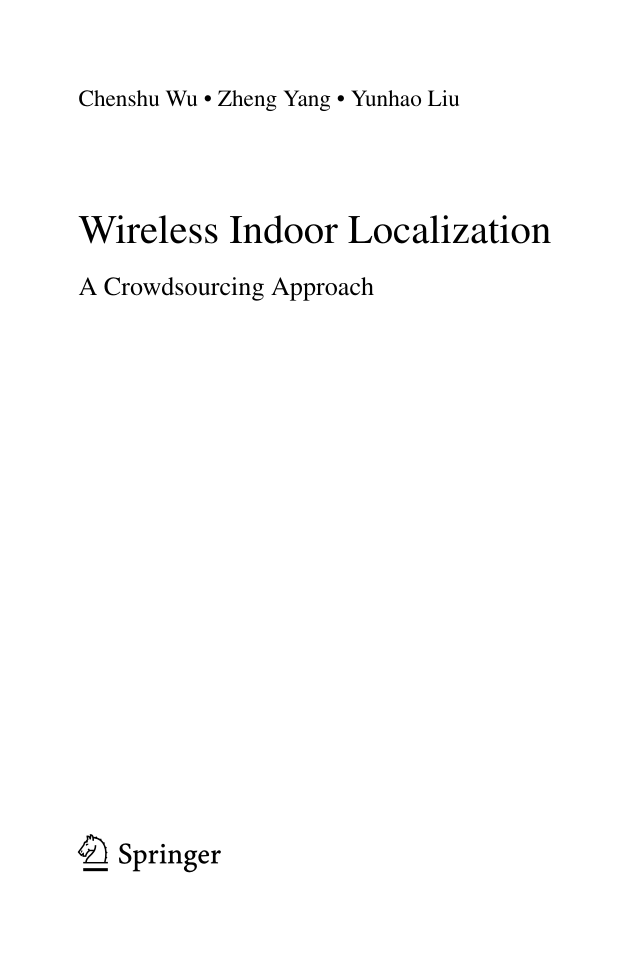
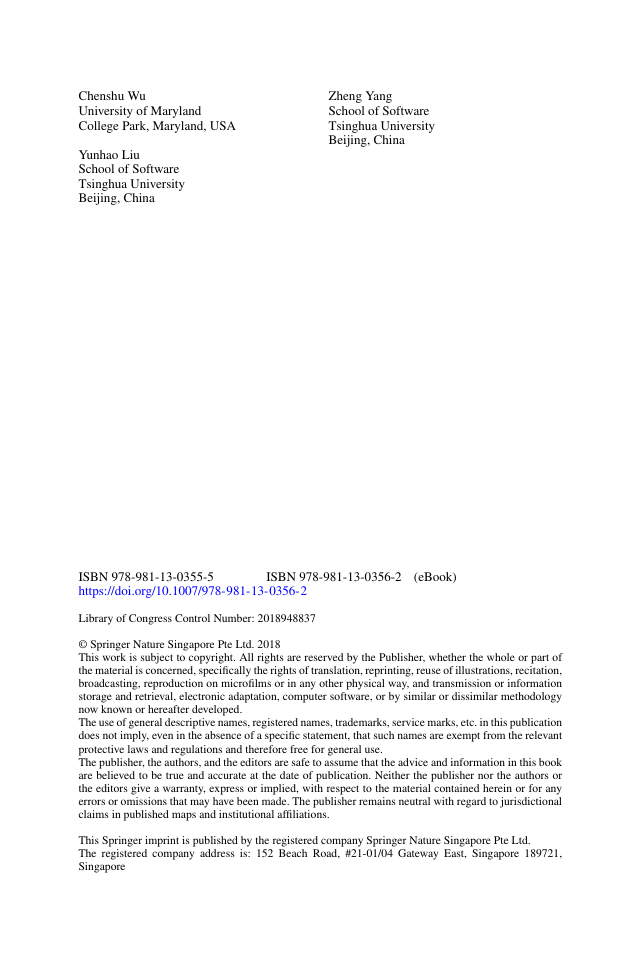
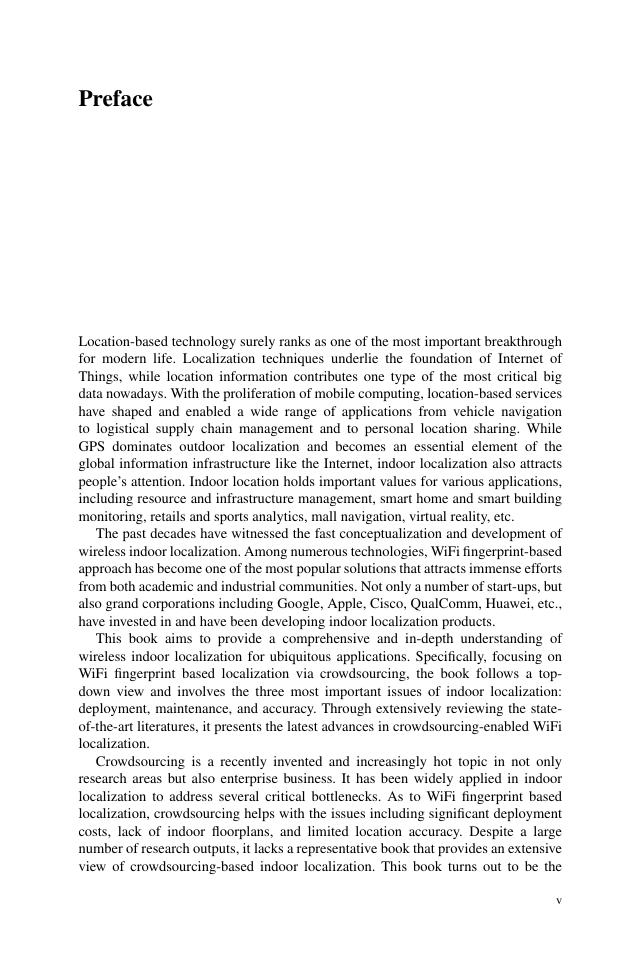
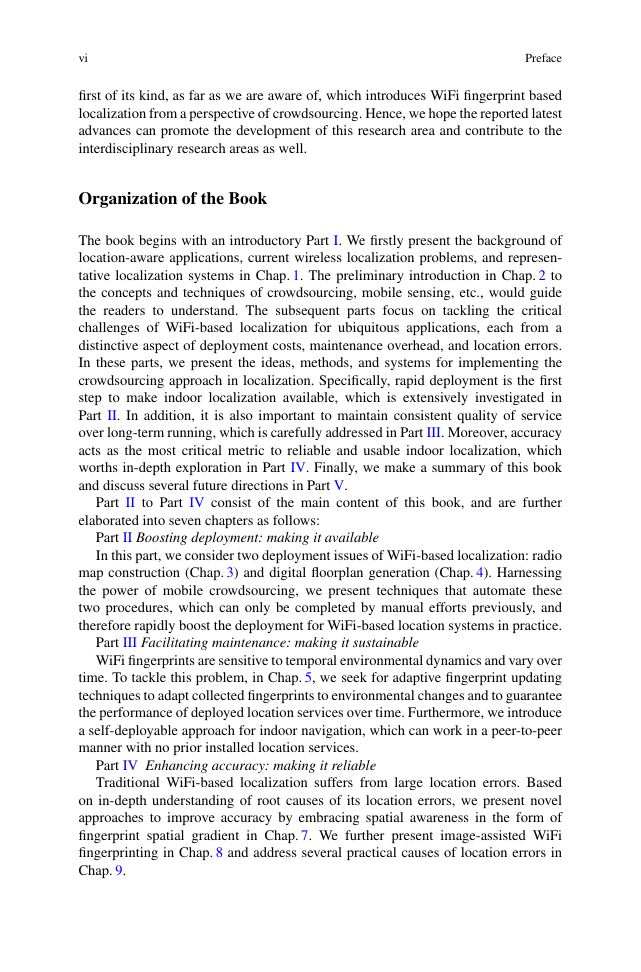
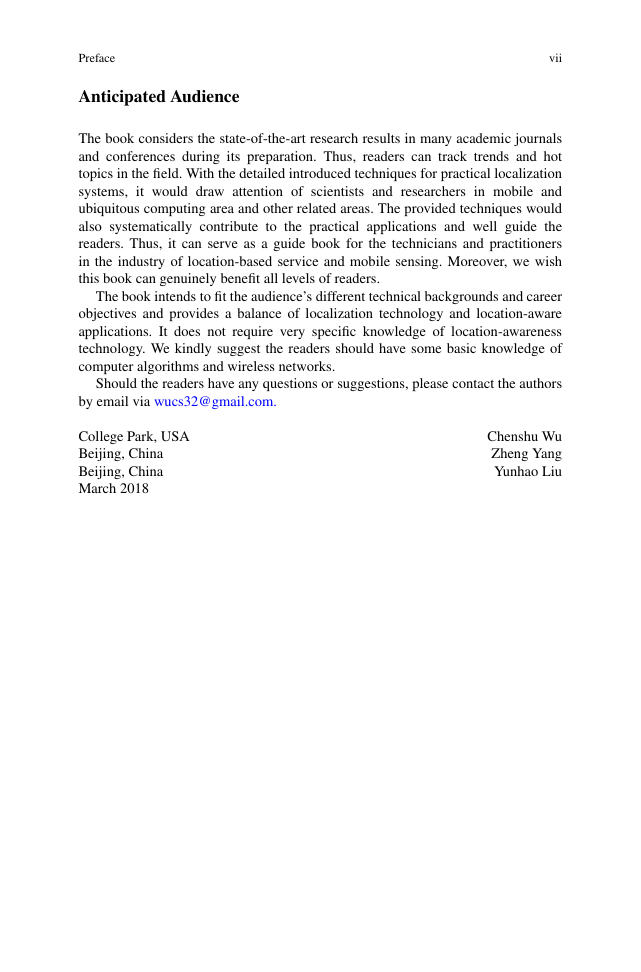
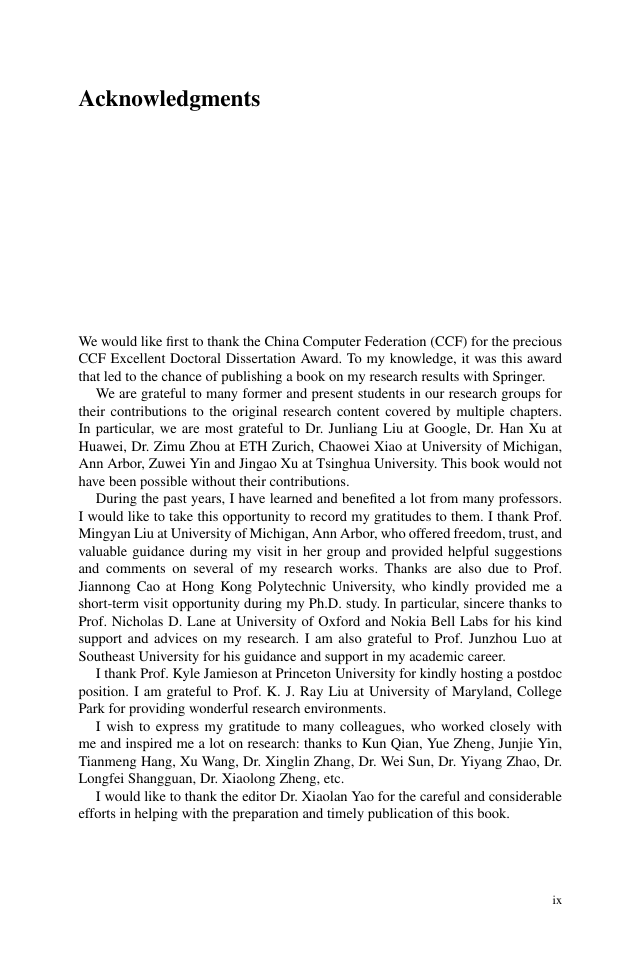








 2023年江西萍乡中考道德与法治真题及答案.doc
2023年江西萍乡中考道德与法治真题及答案.doc 2012年重庆南川中考生物真题及答案.doc
2012年重庆南川中考生物真题及答案.doc 2013年江西师范大学地理学综合及文艺理论基础考研真题.doc
2013年江西师范大学地理学综合及文艺理论基础考研真题.doc 2020年四川甘孜小升初语文真题及答案I卷.doc
2020年四川甘孜小升初语文真题及答案I卷.doc 2020年注册岩土工程师专业基础考试真题及答案.doc
2020年注册岩土工程师专业基础考试真题及答案.doc 2023-2024学年福建省厦门市九年级上学期数学月考试题及答案.doc
2023-2024学年福建省厦门市九年级上学期数学月考试题及答案.doc 2021-2022学年辽宁省沈阳市大东区九年级上学期语文期末试题及答案.doc
2021-2022学年辽宁省沈阳市大东区九年级上学期语文期末试题及答案.doc 2022-2023学年北京东城区初三第一学期物理期末试卷及答案.doc
2022-2023学年北京东城区初三第一学期物理期末试卷及答案.doc 2018上半年江西教师资格初中地理学科知识与教学能力真题及答案.doc
2018上半年江西教师资格初中地理学科知识与教学能力真题及答案.doc 2012年河北国家公务员申论考试真题及答案-省级.doc
2012年河北国家公务员申论考试真题及答案-省级.doc 2020-2021学年江苏省扬州市江都区邵樊片九年级上学期数学第一次质量检测试题及答案.doc
2020-2021学年江苏省扬州市江都区邵樊片九年级上学期数学第一次质量检测试题及答案.doc 2022下半年黑龙江教师资格证中学综合素质真题及答案.doc
2022下半年黑龙江教师资格证中学综合素质真题及答案.doc